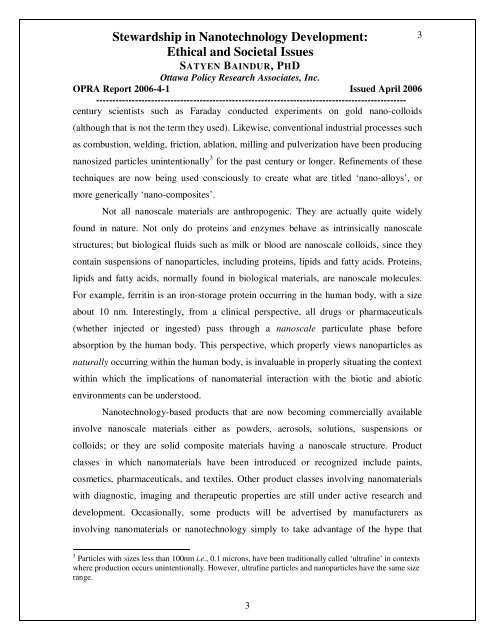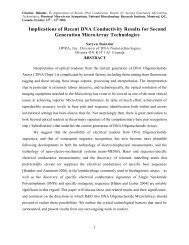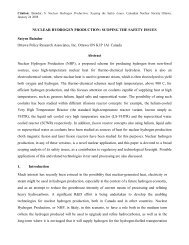Development Ethical and Societal Issues Satyen Baindur PhD
Ethical and Societal Issues - Satyen.Baindur.Org
Ethical and Societal Issues - Satyen.Baindur.Org
You also want an ePaper? Increase the reach of your titles
YUMPU automatically turns print PDFs into web optimized ePapers that Google loves.
Stewardship in Nanotechnology <strong>Development</strong>:<br />
<strong>Ethical</strong> <strong>and</strong> <strong>Societal</strong> <strong>Issues</strong><br />
SATYEN BAINDUR, PHD<br />
Ottawa Policy Research Associates, Inc.<br />
OPRA Report 2006-4-1 Issued April 2006<br />
------------------------------------------------------------------------------------------------<br />
century scientists such as Faraday conducted experiments on gold nano-colloids<br />
(although that is not the term they used). Likewise, conventional industrial processes such<br />
as combustion, welding, friction, ablation, milling <strong>and</strong> pulverization have been producing<br />
nanosized particles unintentionally 3 for the past century or longer. Refinements of these<br />
techniques are now being used consciously to create what are titled ‘nano-alloys’, or<br />
more generically ‘nano-composites’.<br />
Not all nanoscale materials are anthropogenic. They are actually quite widely<br />
found in nature. Not only do proteins <strong>and</strong> enzymes behave as intrinsically nanoscale<br />
structures; but biological fluids such as milk or blood are nanoscale colloids, since they<br />
contain suspensions of nanoparticles, including proteins, lipids <strong>and</strong> fatty acids. Proteins,<br />
lipids <strong>and</strong> fatty acids, normally found in biological materials, are nanoscale molecules.<br />
For example, ferritin is an iron-storage protein occurring in the human body, with a size<br />
about 10 nm. Interestingly, from a clinical perspective, all drugs or pharmaceuticals<br />
(whether injected or ingested) pass through a nanoscale particulate phase before<br />
absorption by the human body. This perspective, which properly views nanoparticles as<br />
naturally occurring within the human body, is invaluable in properly situating the context<br />
within which the implications of nanomaterial interaction with the biotic <strong>and</strong> abiotic<br />
environments can be understood.<br />
Nanotechnology-based products that are now becoming commercially available<br />
involve nanoscale materials either as powders, aerosols, solutions, suspensions or<br />
colloids; or they are solid composite materials having a nanoscale structure. Product<br />
classes in which nanomaterials have been introduced or recognized include paints,<br />
cosmetics, pharmaceuticals, <strong>and</strong> textiles. Other product classes involving nanomaterials<br />
with diagnostic, imaging <strong>and</strong> therapeutic properties are still under active research <strong>and</strong><br />
development. Occasionally, some products will be advertised by manufacturers as<br />
involving nanomaterials or nanotechnology simply to take advantage of the hype that<br />
3<br />
3 Particles with sizes less than 100nm i.e., 0.1 microns, have been traditionally called ‘ultrafine’ in contexts<br />
where production occurs unintentionally. However, ultrafine particles <strong>and</strong> nanoparticles have the same size<br />
range.<br />
3










